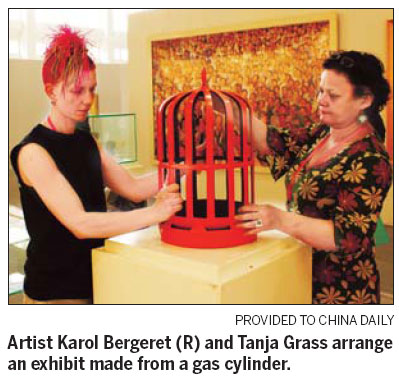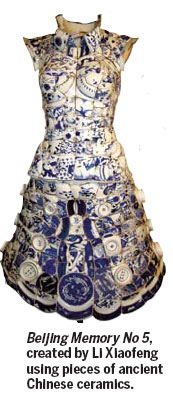Community
From trash can to the gallery wall
By Laura Morgan (China Daily)
Updated: 2011-05-03 07:56
 |
Large Medium Small |

"Art" and "rubbish" are not two words that budding artists would use together to describe their work. However, for Spanish non-profit art association, Drap-Art, the rubbish is the art.
Drap-Art encourages artists to transform discarded items into works of art.
The organization recently touched down for the first time in Beijing to prepare for the Recycling Art Exhibition, to be held at the Spanish Cultural Center, the Instituto Cervantes, from Thursday.

Drap-Art has been supporting recycling art since 1996 and holds an annual festival in Barcelona to promote new consumption habits and highlight the negative aspects of consumerism.
"We are living in a consumer society where we have become accustomed to the idea that we can just buy things and then throw them away, but the resources of the planet are limited and so this just cannot go on," explained Tanja Grass, the president of the Drap-Art Festival.
While ecologists can produce many facts and figures about the effects that a
consumerist lifestyle has on the planet, an indirect approach by artists that retells the message in a more easily accessible way often helps spread the message further.
"The general public need to be introduced to the idea of what you can do with trash creatively and what a resource trash can be," said Grass. The Recycling Art Exhibition aims to do just that, by displaying works of art created from everyday objects people discard.
"We think that when people see what value you can give to trash, they change their way of consuming," said Grass. "People start to feel bad about throwing things away. If you want to stop feeling bad about throwing things away, you must think more before you buy."
The artworks are more than a simple review of consumerism. Many of the artists use their recycled creations as platforms to display other meanings or stimulate different ideas.
Karol Bergeret pays homage to the traditional role of women by using old ironing boards and fabrics, while Rafael Arroyo Villemur creates curious creatures out of a mishmash of chicken bones, wire and enamel.
The recycled art also shows people how everyday goods and rubbish can be used to bring creativity into their lives.
Another standout in the show is Chinese artist Li Xiaofeng, who specializes in creating something completely new from something ancient. Li transfigures shattered pieces of ancient Chinese ceramics, gathered from archaeological sites, into avant-garde fashion. The artist binds together shards of porcelain, some of which date back to the Song Dynasty, with silver wire to create unique, "wearable" costumes (although these outfits do weigh about as much as a suit of armor).
As part of a cross-cultural exchange between artists, and to help their message of sustainability reach a Chinese audience, the exhibition will also feature alongside Li three other local artists who also work with used goods and rubbish.

In the run-up to the exhibition, many of the recycled artworks were briefly exhibited as part of Art Beijing over the weekend.
And while the mere mention of art made with chicken bones or pieces of porcelain may sound crass and draw reservations, it's worth putting presumptions aside. The exhibition breaks barriers in producing poetic pieces that are made with everyday items and it might just make you think before you throw something away.
| 分享按钮 |